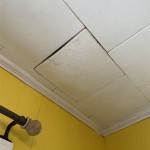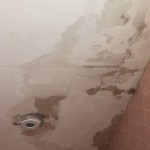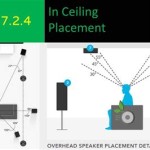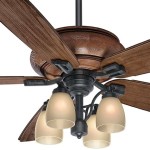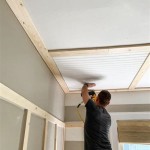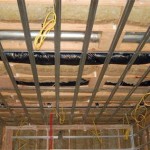Toilet Overflowed, Leaked Through Ceiling: Causes, Cleanup, and Prevention
A toilet overflowing and subsequently leaking through the ceiling below is a homeowner's nightmare. This unpleasant event can cause significant damage, disrupt daily life, and lead to costly repairs. Understanding the causes, proper cleanup procedures, and preventative measures can help minimize the impact of this plumbing emergency.
Causes of Toilet Overflows and Ceiling Leaks
Several factors can contribute to a toilet overflowing and leaking through the ceiling. One common culprit is a clog in the toilet drain. This blockage can be caused by excessive toilet paper, foreign objects flushed down the toilet, or buildup of mineral deposits and waste over time. When the drain is blocked, water backs up into the bowl and eventually overflows onto the floor.
Another potential cause is a malfunctioning fill valve. The fill valve controls the amount of water that enters the tank after each flush. If the valve fails to shut off properly, the tank will overfill, leading to an overflow. A faulty flapper can also cause overflow. The flapper acts as a seal between the tank and the bowl. If it's worn or damaged, water can continuously leak from the tank into the bowl, eventually causing an overflow.
A blocked vent pipe can also contribute to overflow issues. The vent pipe allows air to enter the plumbing system, facilitating proper drainage. If the vent is blocked by debris, such as leaves or bird nests, it can create a vacuum effect, slowing or stopping the drainage process and leading to overflows.
In older homes, sewer line issues can also be a factor. Tree roots can infiltrate sewer lines, causing blockages and backups that affect all plumbing fixtures, including toilets. Similarly, a collapsed or damaged sewer line can restrict flow and lead to backups and overflows.
Cleanup Procedures After a Toilet Overflow and Ceiling Leak
Addressing a toilet overflow and subsequent ceiling leak requires prompt and thorough action to minimize damage and prevent mold growth. The first step is to stop the overflow. Turn off the water supply to the toilet using the shut-off valve located behind the toilet. This will prevent further water from entering the tank and bowl.
Next, remove any standing water on the bathroom floor and the affected area below the ceiling leak. Use towels, mops, and a wet/dry vacuum to extract as much water as possible. It's crucial to dry the affected areas thoroughly to discourage mold and mildew growth. Fans and dehumidifiers can accelerate the drying process.
If the ceiling material is saturated, it might be necessary to remove it to prevent further damage and allow for proper drying of the underlying structure. This should be done carefully to avoid further structural issues. Wear appropriate safety gear, such as gloves and eye protection, during cleanup.
Disinfect all affected surfaces with a solution of bleach and water (1 part bleach to 10 parts water). This will kill any bacteria or germs that may be present. Porous materials such as carpets and padding may need to be professionally cleaned or replaced if heavily saturated.
Preventing Future Toilet Overflows and Ceiling Leaks
Taking proactive steps can significantly reduce the risk of future toilet overflows and ceiling leaks. Regularly inspect the toilet for any signs of leaks or malfunctions. Check the fill valve and flapper for proper operation and replace them if necessary.
Avoid flushing anything other than toilet paper and human waste down the toilet. Foreign objects, such as feminine hygiene products, wipes, and cotton swabs, can easily clog the drain. Educate all household members about proper toilet usage.
Periodically flush the toilet with hot water to help prevent mineral buildup and keep the drain clear. Consider installing a drain strainer to catch hair and other small debris that might otherwise go down the drain.
Have the sewer line inspected and cleaned by a professional plumber every few years. This can help identify potential issues, such as root intrusion or pipe damage, before they escalate into major problems. Ensure proper ventilation of the plumbing system. Check the vent pipe for obstructions and clear them if necessary.
Consider installing a water leak detector near the toilet. These devices can alert homeowners to leaks early on, allowing for prompt action to prevent significant damage. For older homes, consider a sewer backflow preventer to prevent sewage from backing up into the home in the event of a sewer line blockage.
Addressing a toilet overflow and ceiling leak promptly and effectively can minimize damage and disruption. Understanding the causes, following proper cleanup procedures, and implementing preventive measures can help protect homes from this common plumbing problem.

Toilet Overflow Caused Water To Enter The Ceiling Cavity How Remediate Greenbuildingadvisor
Nyc Floods Were So Bad Water Came Through Ceiling Of 4 000 Apartment Business Insider

4 Causes Of Water Stains On Your Ceiling Ways To Respond

Ceiling Water Damage How To Repair

Our Toilet Leaked Through The Ceiling Below Young House Love

What Causes A Toilet To Overflow Alpha Building Inspections

Our Toilet Leaked Through The Ceiling Below Young House Love

Water Leaking From Ceiling Here S What To Do Who Call

Toilet Overflow Cleanup In Little Rock Ar Chenal Restoration

A Few Reasons Why Your Toilet Is Overflowing

